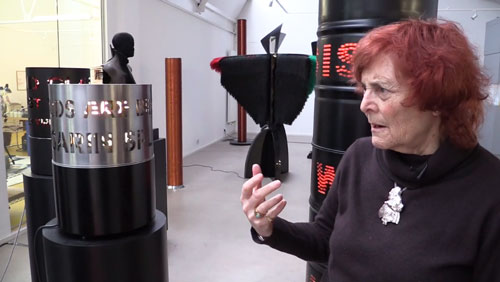
Liliane Lijn in her north London studio, February 2014. Photograph: Martin Kennedy. © Studio International.
After initial introductions and the removal of our soggy outer garments, Lijn conducts a thorough studio tour, turning on each of the amazing and sometimes ominously towering works from across her long career, creating a gentle background whirr, and beginning with some early koans (imperial white rotating cones with slivers of colour slicing through them at angles) and a collection of Poemcons (cones with text carved into them, lit from within, similarly rotating), she progresses via fragmentations of the self (for example, My Body, My Self, 1996) and tales of singing to looming feminine creations (her Cosmic Dramas series from the 80s), to fragmentations of her Aerogel pieces, resulting from a residency with NASA in 2005. With all this talk of stardust and lines of light interacting in four dimensions (the fourth being time), it is hard to believe that Lijn’s scientific knowledge is all self-taught. She shrugs this off nonchalantly, however: “That’s all science is, really, observation. I’m just interested in it and so I read.” It seems that a lot of Lijn’s success comes from “just being interested”. Over more biscuits and more tea, we continue to chat.
Anna McNay: When did you decide that you wanted to become an artist? Was it something you always wanted from childhood?
Liliane Lijn: Well, I did a lot of drawing and painting when I was a child, but, you know, so does everybody else. When I was 12, I wanted to be a writer – actually, a journalist, that was my idea. And if I was going to be an artist, it was fashion. These were very practical ideas. But then I changed language when I was 14 – I left the United States with my parents and went to Europe – and so then writing became complicated. At 17, I decided that I definitely wanted to become an artist.
AMc: How much influence do you think your upbringing had on your wish to become an artist? Both of your parents came from Russian Jewish families.
LL: Yes, I was from a Russian Jewish family, and there were a lot of artists in my family. A lot of musicians. And there were painters too, either family or friends – a lot of refugee painters who came to the United States that my parents either knew or helped. My father’s ambition was to become a writer, and he wrote, but he wrote in German. His English wasn’t that great when he came to New York and he had to make a living, so his ambitions went down the drain. But, I think there was always a lot of music and literature and artists around. I was surrounded with a lot of culture.
Liliane Lijn gives Studio International a tour of some of her key works in her north London studio.
AMc: Do you think the fact that you were bilingual – multilingual – from an early age has played a role in there being so much text in your art?
LL: Definitely, yes. My family spoke six languages and so it was like living in the Tower of Babel! My brother and I, although we understood, never actually spoke any of these languages. We didn’t learn them. We were absolutely adamant that we wanted to speak English because we wanted to be American. That’s typical first generation. I think my interest was in language from a very early age, but that language was constantly shifting and changing, and so, actually, working with visual art was much easier. There was just something much more direct. But, at the same time, I wrote a lot. I wrote poetry from a very early age.
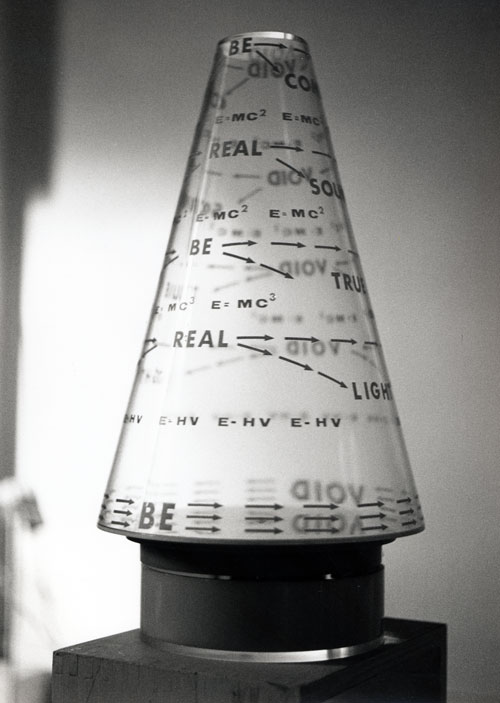
Liliane Lijn. E=MC3 Poemcon, 1968. Letraset on Perspex cone, motorised turntable, 44 x 23.5 x 23.5 cm. Text collaboration between Liliane Lijn and Nazli Nour. Collection the artist. Photograph: Liliane Lijn.
AMc: Where did the idea for your Poem Machines come from?
LL: It started because I had been going to the Science Museum in Paris and I saw a beautiful experiment, which was an experiment in light interference, and I tried to do something similar. I managed to create interference using just lines on cylinders that rotated at a certain speed. And what you’d see, although these lines were black and white, was colour – you’d get colour coming out of it. And then, from that, I thought: “Well, words are made up of letters, and letters are made up of lines, so why not use words?” I thought that might be more interesting.
I started off just using the alphabet and then I was going to do cut-ups from newspapers, but I had a really good friend in Paris, Nazli Nour, and she asked me to work with her poems. It meant cutting them up because they were very long, but she didn’t mind. I started using words from her poems, and then other people asked me to do it with their poems. It was always a question of whose work would be right, and I did find one person, an American poet I met in Greece, Leonard Marshall, whose poetry was just perfect because they were all very, very short poems. He died very young and the only person who published him was me. A lot of the early pieces were his poems and Nazli’s poems, first on drums and then on cones.
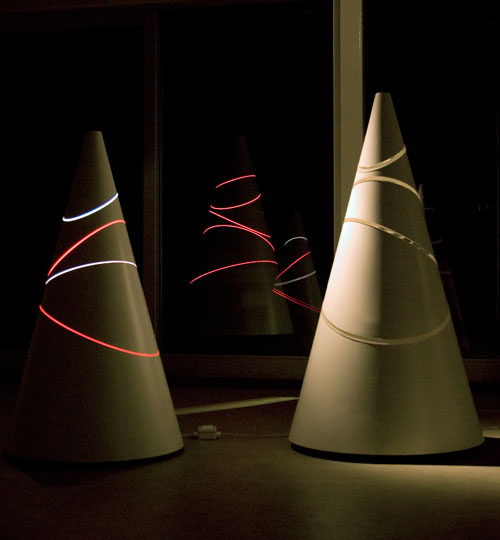
Liliane Lijn. Clear Light Koan respectively, 2008. Glass fibre, Polyester resin, 20mm thick Clear Perspex sections, motorised turntable, 170 x 96 cm diameter; Clear Red Koan, 2008. Glass fibre, Polyester resin, Fluorescent Red, Orange and Green Perspex,
motorised turntable, fluorescent light, 153 x 80 cm base diameter. Government Art Collection. Photograph: Liliane Lijn
.
AMc: And where did the idea of working with cones come from?
LL: I started working on cones first with lines – stripes – because I liked the striped cones on the highway. I thought that was where the idea came from. They were like signals. But then I realised that, a few years earlier, I’d read The Greek Myths by Robert Graves and, in the notes, he talked about these conical mounds, ash mounds, that were white and had fire inside and were considered sacred. They were the emblem of the white goddess. And I’d picked that up and that was the thing that fascinated me. That was a more unconscious, but profound level for using cones. And then I started to call them koans because, from the age of about 18, I’d been interested in Zen Buddhism and koan is a puzzle, a type of riddle that you use to meditate, to empty the mind. So, basically, the cones I was making were able to do that, they were hypnotic, and so I thought they were related.
AMc: You’ve done a lot of work evoking further elements of feminist mythology. How and why did this become part of your work?
LL: It was around 1980 when I realised that was what really interested me. And so I started drawing and trying to elaborate a new image of the feminine. New is a strange word: I didn’t want it to be obviously feminine; I didn’t want it to be connected with the feminine attributes that we always consider as feminine; I didn’t want it to be connected with women’s work or that kind of idea, necessarily, although I didn’t mind if it came into it. I wanted to find a new way of looking at the feminine and to bring into that everything: plants, animals, humans and machines.
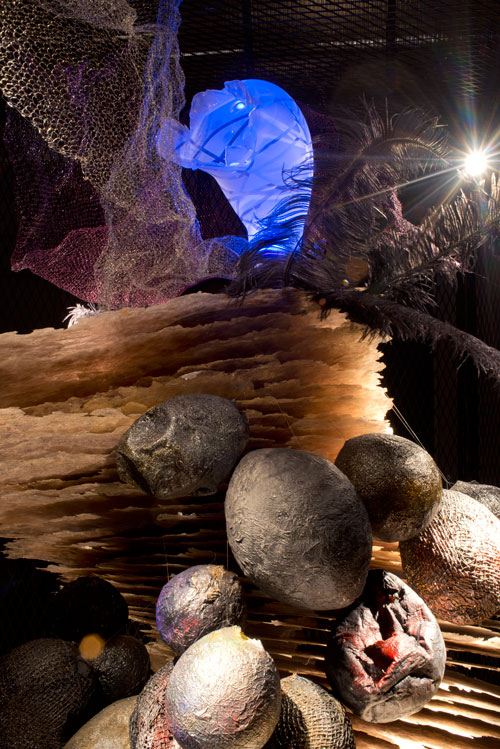
Liliane Lijn. The Bride, 1988. Mixed media performing sculpture, 244 x 244 x 153 cm (8 x 8 x 5 ft). Photograph: Tomek Sierek.
More and more, I felt that machines had this feminine quality, which, of course, people don’t usually think. Both The Bride (1988) and The Electric Bride (1989) began in a very unconscious way. What happened was a curator saw Woman of War (1986) and Lady of the Wild Things (1983) and she was organising a show on the theme of “the wedding” and asked me if I could make a figure similar to those, but that would relate to the wedding. My first reaction was: “I don’t think so!” I mean, I’m not really interested in marriage. But then suddenly I was overwhelmed. I had a complete emotional experience – it was like a surge of emotion – and so I said to her to let me think about it. I went away and I couldn’t understand the reasons for my feelings. I started exploring it in drawings and realised that I had understood the meaning of “bride” on another level – the mythological level – so The Bride is Persephone, who is taken away to the underworld. But then, when I made The Electric Bride, I read the mythology of Sumer and Inanna, which is a much more interesting myth – the Persephone myth, in fact, comes from the Sumerian myth – and Inanna actually goes down to the underworld not because she is raped or violated or taken away by a male, but because the Queen of the Underworld is her sister, Ereshkigal. And her sister murders her. It’s very violent really! It’s all about death and rebirth; the fear of death and the hope of rebirth. So those two pieces are really about that.
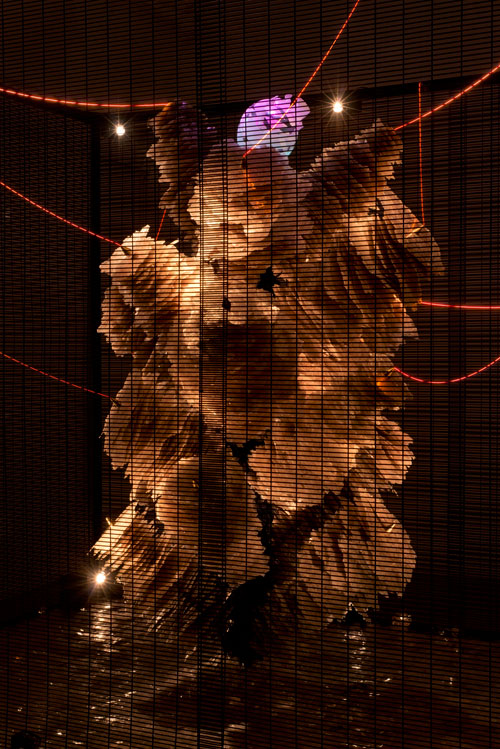
Liliane Lijn. The Electric Bride, 1989. Aluminium, steel, cock feathers, Elmflex micanite, brass, blown glass, 280 x 300 x 240 cm (9’4” x 10’ x 8’). Photograph: Thierry Bal.
AMc: And then you began to use your own body in your work?
LL: After I made the archetypes, yes. I had this problem with my back and I couldn’t work for a year and, after that, probably because of that, I started looking into myself. The first thing that I felt was fragmented. And so I started working with fragmentation and using my physical body and bronze casts of my body. But, unlike most bronze casts, I did them on my skin, so every single detail was visible. And I did them in fragments, so when I came to put them together, I put them together like a puzzle. And if I’d do, say, my bust, and then three days later I’d do my head, I wouldn’t know how I’d stood for my bust, and so the head wouldn’t fit on to the body when I then tried to put it together. And that was really interesting because it made me really realise how I’d always felt that my body didn’t really fit, and that my head and body were separate, and the problems of this separation, particularly for a woman. And I felt that this was a very feminine problem, although it’s perhaps also a problem of our time, when people become all heads and lose their bodies – or they’re all body and no head!
AMc: You studied art history and archaeology at the École du Louvre and the Sorbonne, am I right?
LL: Yes. My father didn’t want me to study art. He wanted me to study philosophy and literature. So this was a compromise because he didn’t value art. He thought that the history of it was more intellectual and that it would get me a better diploma.
AMc: How much do you feel your work has been influenced by the various artistic and literary movements and groups you’ve had contact with, for example, Surrealism, Dada, kinetic art, beat poets, concrete poetry?
LL: A lot. I feel like a sponge, I absorb everything. I think they took a lot from me too, though. I think artists are sponges, I really do. If they’re not, they’re not going to be very good. Obviously there’ll be some things you reject – you’re not going to be interested in everything. I wasn’t particularly interested in pop art. And certain aspects of kinetic art never interested me either. I’m not interested in movement for its own sake and I was never too interested in the op qualities. I had my own interests. I was interested in the way in which light and shadow create movement. And that’s why my works move. The very first works that I made that moved came about because I noticed that if something I did on Perspex created a shadow, as I walked around it, the shadow changed place, and so I started making projectors with turning lenses so that it would move all the time, even if you stood still.
AMc: Do you align yourself with any particular movement, or do you see your work as standalone?
LL: Oh, standing alone is very dangerous! You don’t really want to try to stand alone, it’s very hard. I think I’m part of the kinetic movement. I’m also part of the concrete poetry movement. I can’t call myself a beat poet because I’m too young. But I feel like, for years, I’ve been part of the avant garde. I don’t think I’ve ever really got absorbed by the establishment. I’ve worked in performance, and science and art.
AMc: Do you see art and science as separate disciplines, or do you think there is, or ought to be, more overlap?
LL: Oh no, they’re separate disciplines. I’m interested in science and I’ve had the opportunity to collaborate with scientists and so, in a sense, the work itself is a kind of collaborative effort where science and art come together, but it’s always art – I don’t think you can see it as science. Pure science is when you’re getting data and then sorting it, looking at it and trying to find out what’s happening. But, in a way, a lot of art’s like that too, so there are areas where they overlap.
AMc: But you also have mythical elements in your work.
LL: Yes, but the mythical, spiritual and scientific don’t contradict each other. They’re very close together. Joseph Campbell spoke a lot about that. He’s a mythographer, of course. I myself am always a little wary to talk about spirituality, to call it that, to talk about it in those terms, because it all sounds a little new ageist and I find it can be totally trivialised. Basically, I suppose, I’m interested in the unconscious, and that’s the wellspring of where a lot of the most important discoveries are made, whether in art or science or poetry or music. And our culture comes from this deep wellspring, which is probably unconscious and genetic and goes back millennia. So, for me, that’s what I call spiritual. I don’t believe in God, I don’t believe in spirits, I just think that there’s something more. I don’t believe in the mechanical psyche, let’s put it that way. A lot of cultures today think that human beings are basically machines, but I don’t.
AMc: You spoke about the archetype earlier. Is that part of the unconscious?
LL: Yes, the archetype is the unconscious. And it’s very, very profound and it goes back in time. Archetypes belong to all time and to all people and so they’re very powerful and important. But I think human beings neglect all that and I think it can be neglected at peril because they have a certain independence. And that’s what Zen Buddhism teaches you. And not just Buddhism; psychoanalysis, which is very similar really, teaches you that, if you are not aware, you can make tremendous mistakes because you are not directing yourself, something else is. And a lot of the huge tragedies that are happening all the time in the world are happening because of that. Archetypes are dominating people instead of people being aware of them and having control, or attempting to.
AMc: Do you think that being a woman has made things any harder for you in terms of achieving success or being taken seriously in the art world? In particular, working as you do with science and technology, kinetic art and large-scale sculptures?
LL: Yeah, I think being a woman’s very difficult. I think it’s still a problem. Everyone’s talking about it in politics and business. And although it’s getting better, there’s definitely gender discrimination. And now there’s also age discrimination. Well, there’s always been age discrimination, except that when I was 20, it was in reverse, it was against young people and now it’s against people who are older. There’s always discrimination. People just tend to behave like that.
AMc: You’ve lived in a lot of different cities and countries, but, since 1966, have been largely settled in London. What is it that keeps you here?
LL: I often ask myself that! Definitely not the weather! Basically, because I have a family here. I met my partner here and he wanted to stay – attachments, that’s the right word, the Buddhist word attachments.
AMc: Which of your works are you most proud of, or happy with? Or which do you feel is the most significant of your career so far?
LL: That’s a very difficult question. I think the series of the Cosmic Dramas – Woman of War, Lady of the Wild Things, The Bride and The Electric Bride – are the most major works I’ve made. I made all of these pieces in the 80s and they took 10 years to make. They’re the most complex works I’ve made.
AMc: Is there any piece of work you dream of realising which, as yet, has not been possible?
LL: Oh God, yes! The Dance for the Fourth Plinth, for example. [Lijn was on the shortlist of four finalists for the 2015 and 2016 Fourth Plinth commissions, but lost out to Hans Haacke and David Shrigley.] I would really like to realise those two pieces. They don’t have to be on a plinth, they could be somewhere else, but I’d really like to realise them as I think they’d be spectacular as a piece of public work. And then I have another piece, which I recently designed, a big piece, it was supposed to be 23 metres high and 8 metres diameter and all made out of glass bricks, like a wall, stacked, clear, translucent, and using a particular kind of glass, so that when you walk round it, it changes colour. That’s another wonderful commission I didn’t get [for the Half Marathon in Tyneside]. They didn’t think it was practical enough. They weren’t convinced about the way we wanted to build it, because I wanted to employ out-of-work students, because it’s very simple to build. You don’t need to be skilled. It’s unskilled labour. We could have trained them and they could have built the whole thing in a month and a half. So I need to find a new commissioner for that. And there are loads of other things I want to make.
AMc: You’ve said before that the role of the artist is to experiment continually and never to feel that he or she has accomplished anything. Do you feel this way yourself?
LL: Yes…
AMc: But surely you’ve accomplished a lot?
LL: Yes, but you don’t feel it! I suppose because there’s always so much more that you want to do and what you’ve done is done and you don’t really think about it.
AMc: Finally, how, and for what, would you like to be remembered?
LL: I think, if anything, I’d like to be remembered for giving some joy to people. I personally feel that that is the most important function of art: awareness and joy. I don’t see art as a way of criticising politics; I don’t really feel that that’s a function of art. In a sense, if a work of art makes you aware, and wakes you up, enlightens you, then it’s given you the best thing it can give you and everything else will come afterwards.
Interview by ANNA McNAY
Filmed by MARTIN KENNEDY